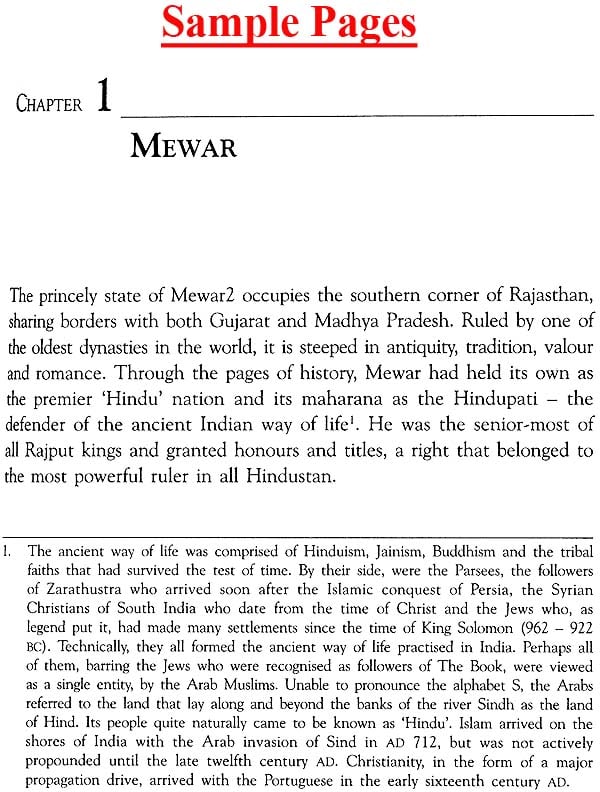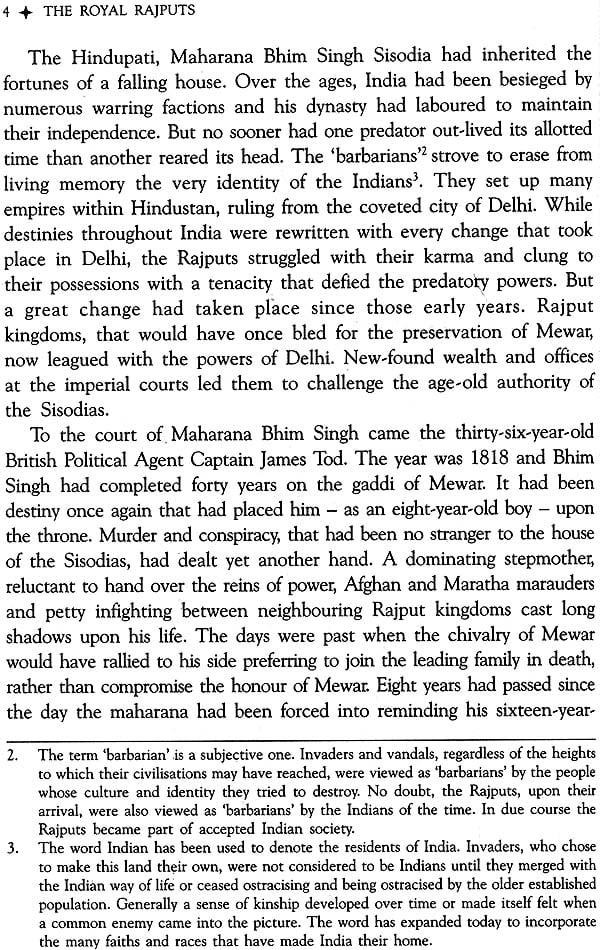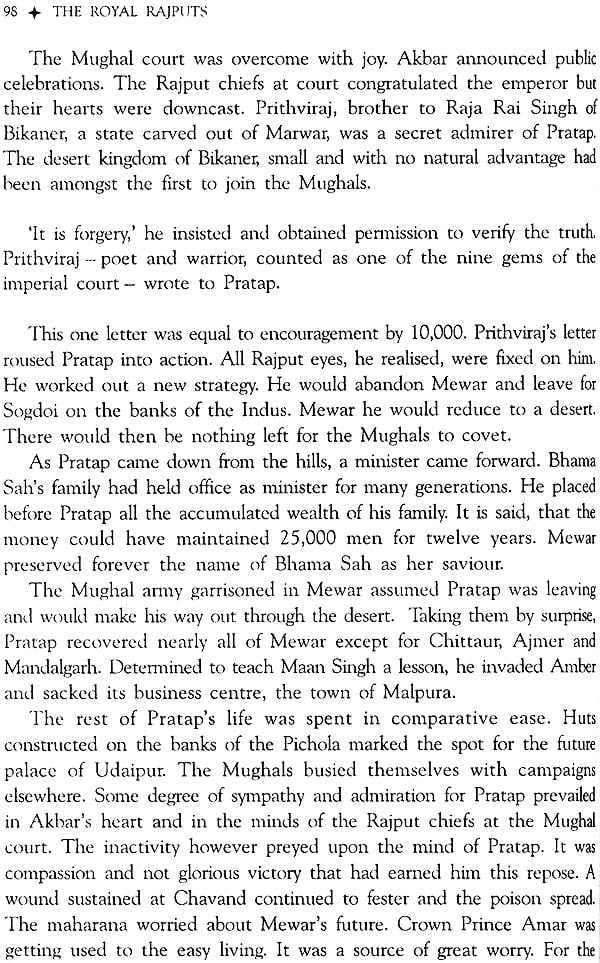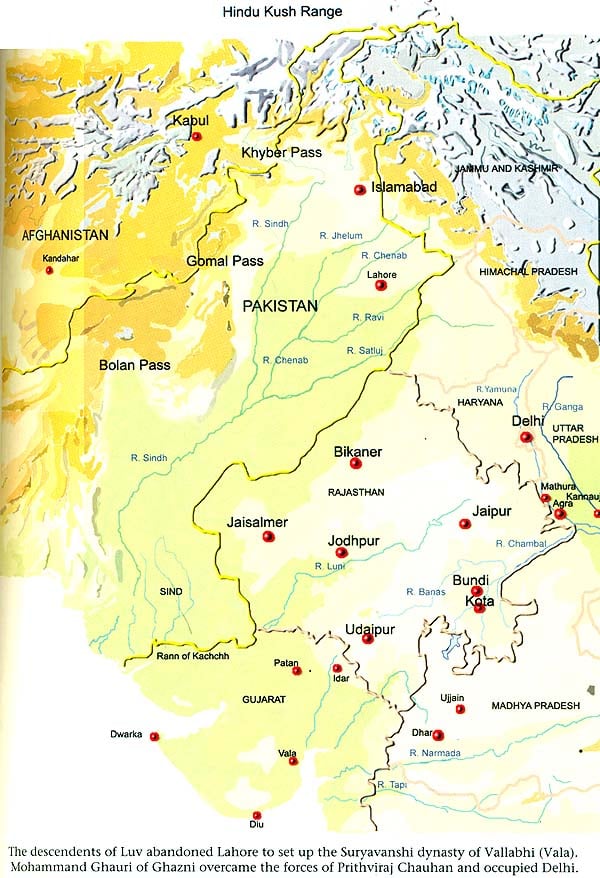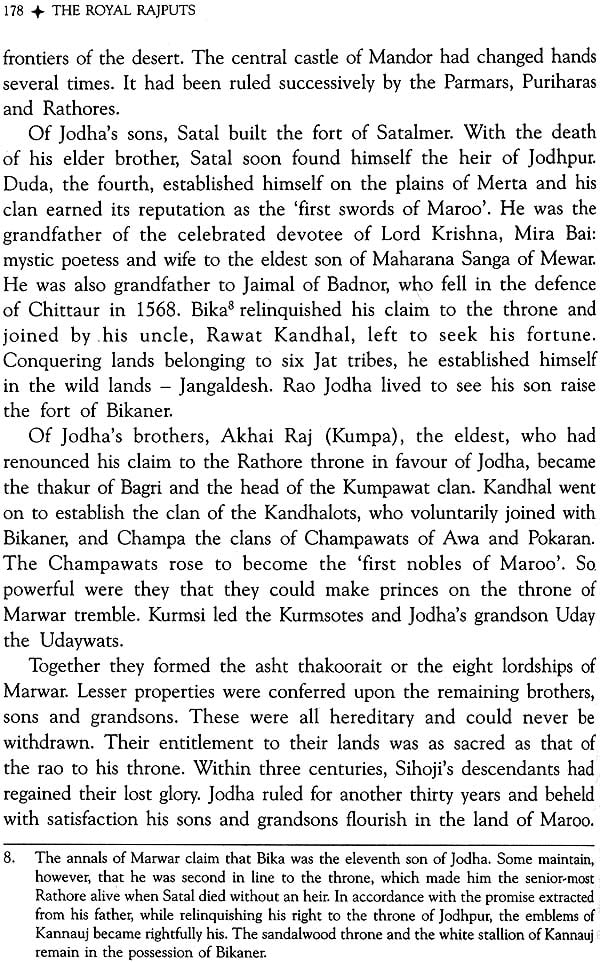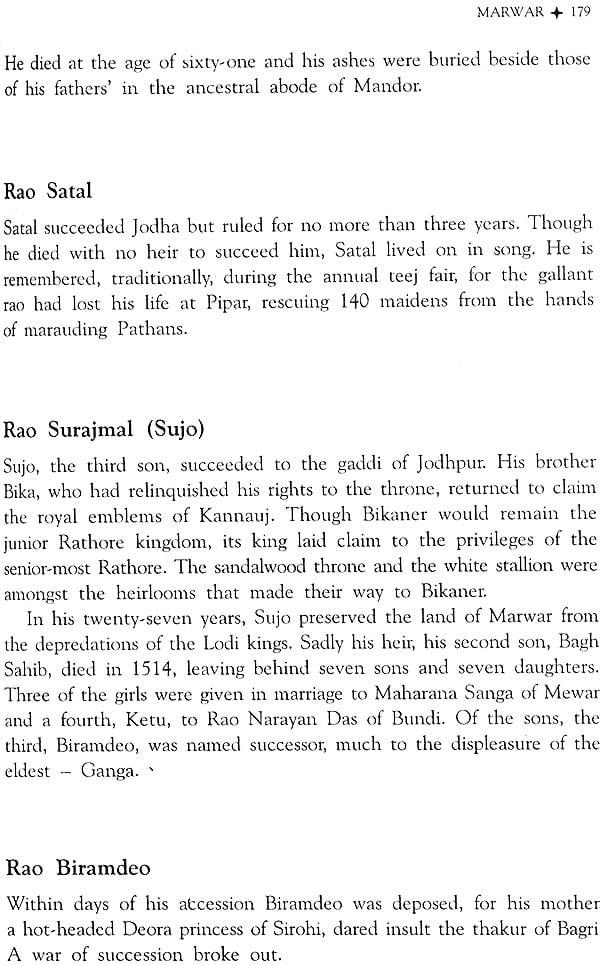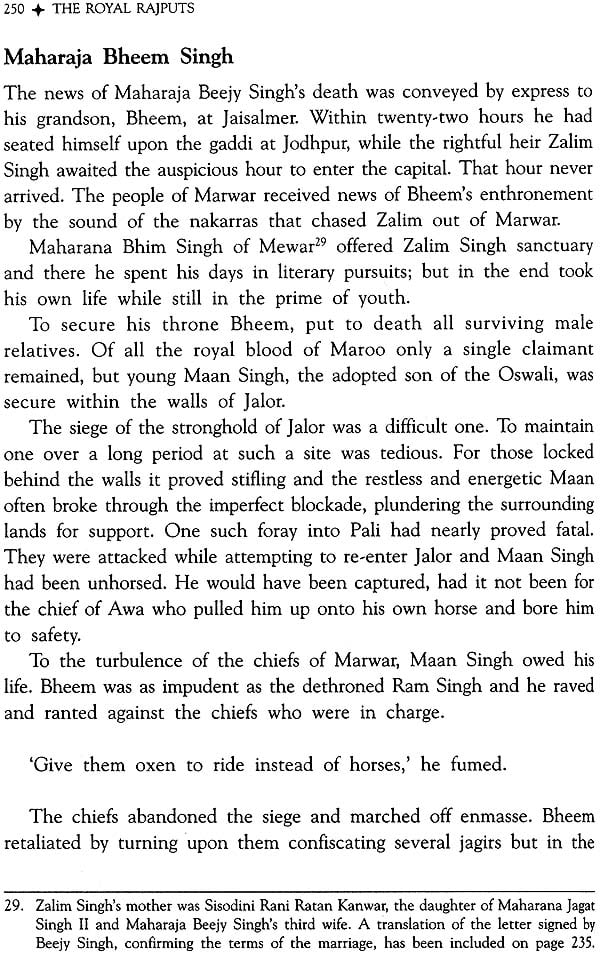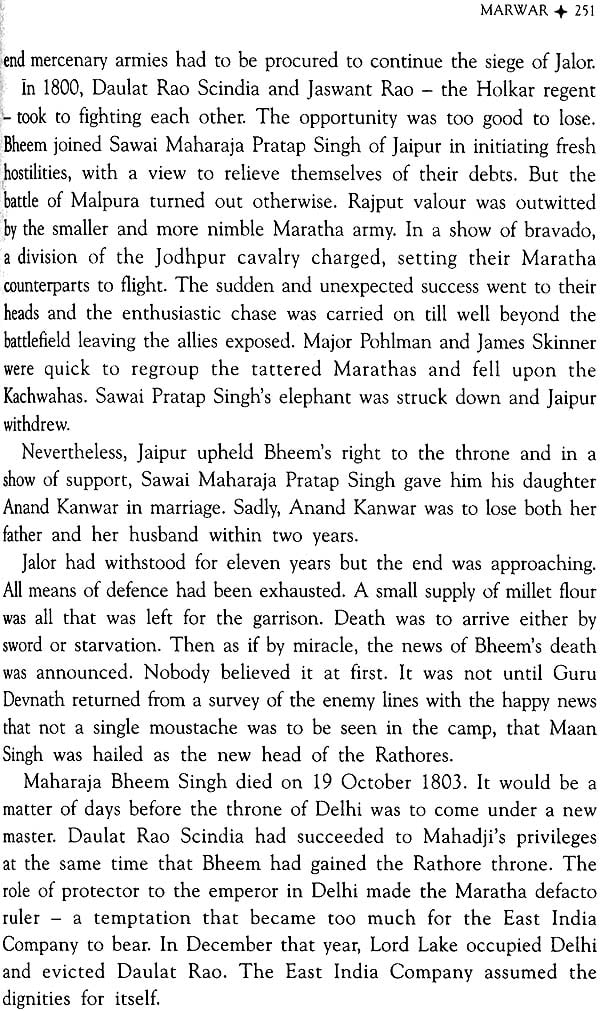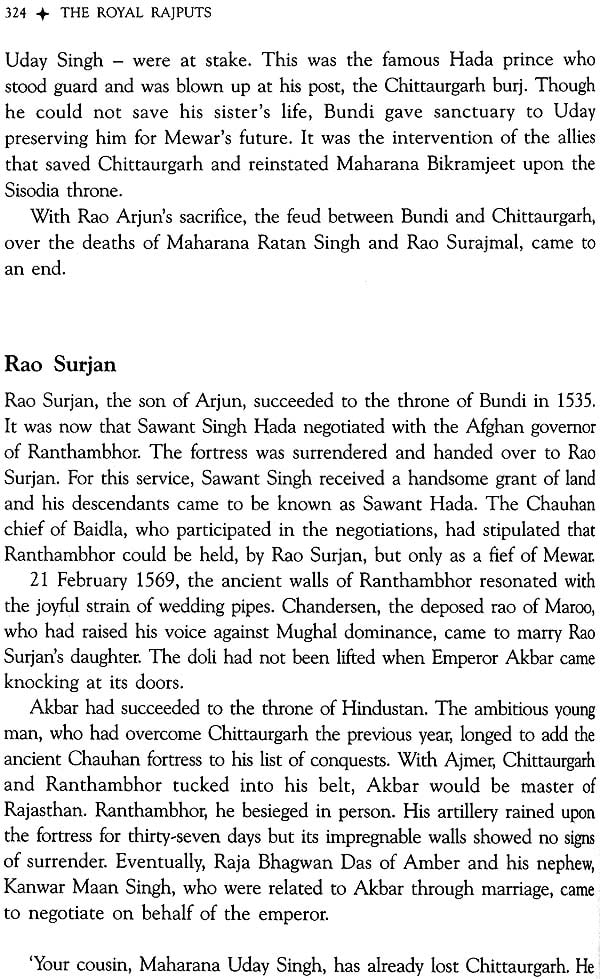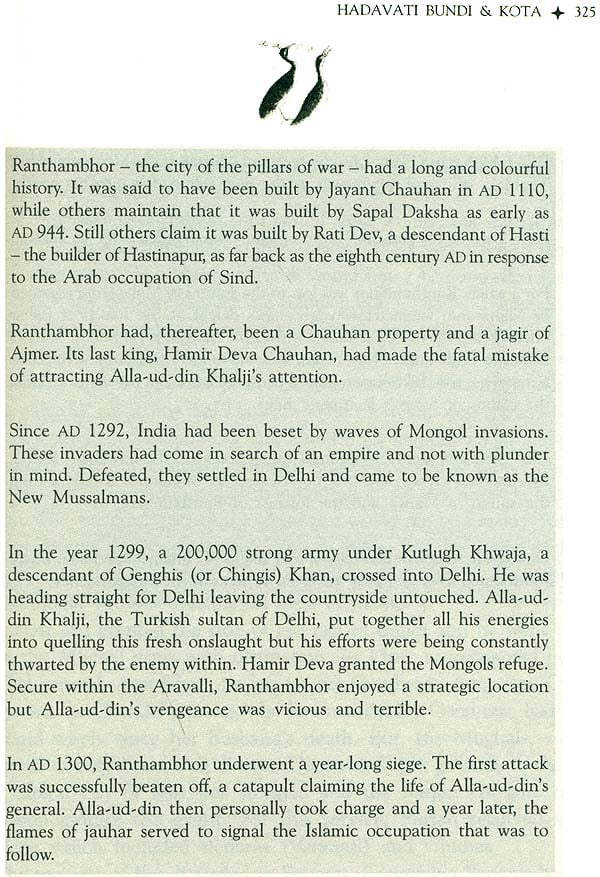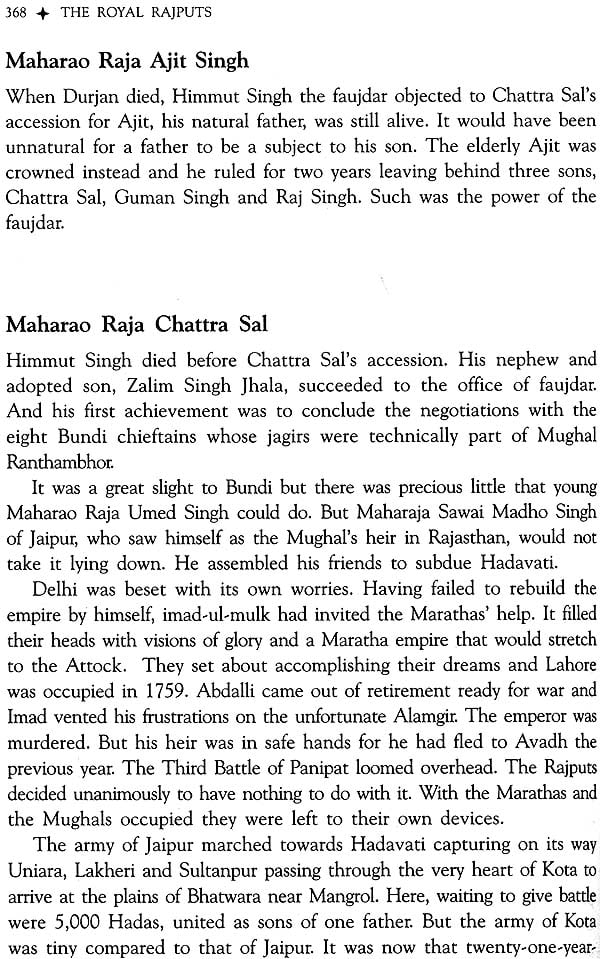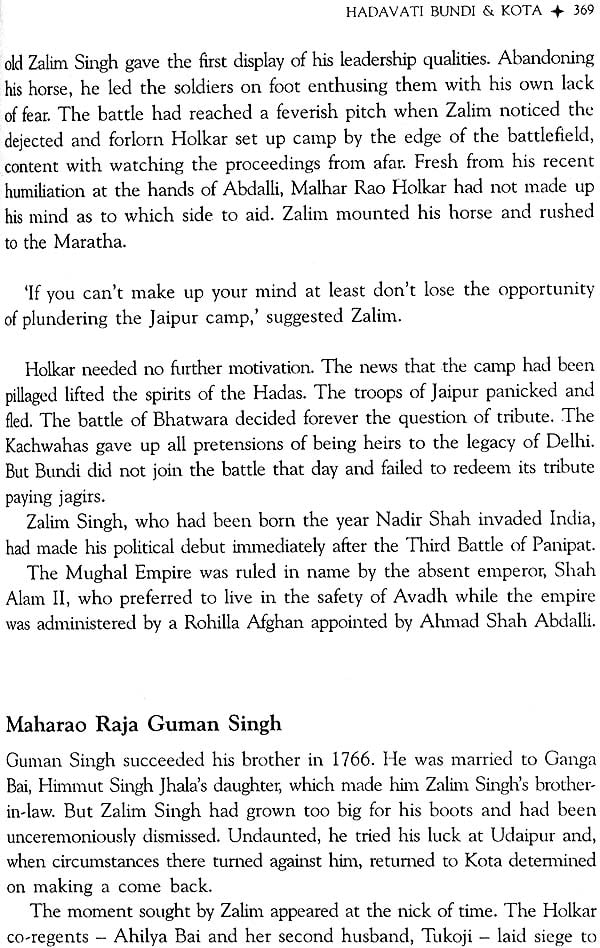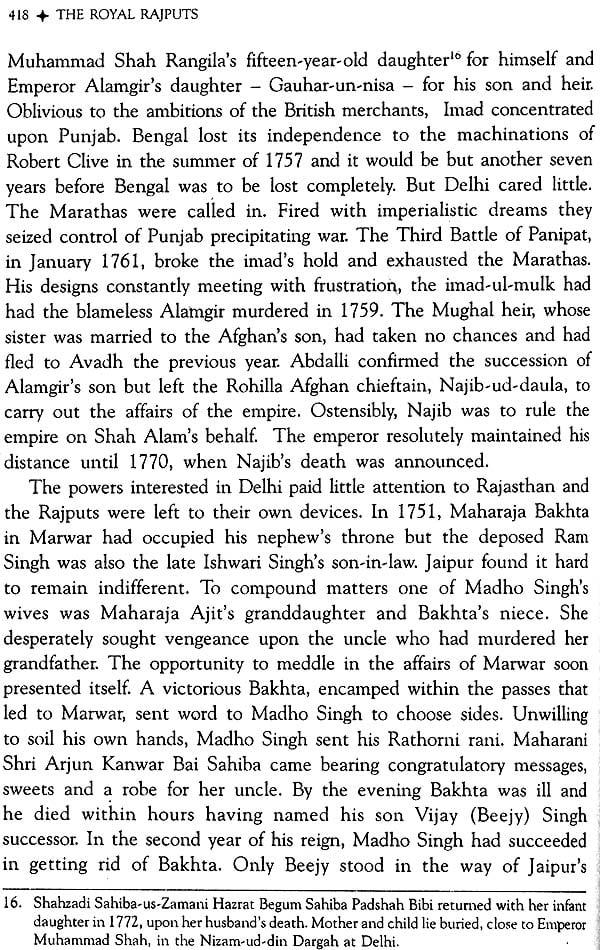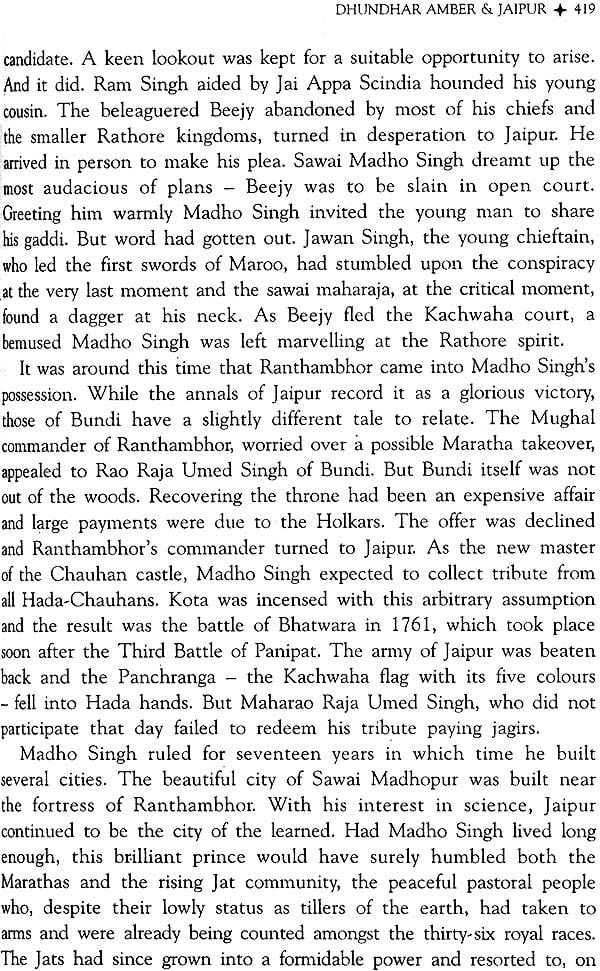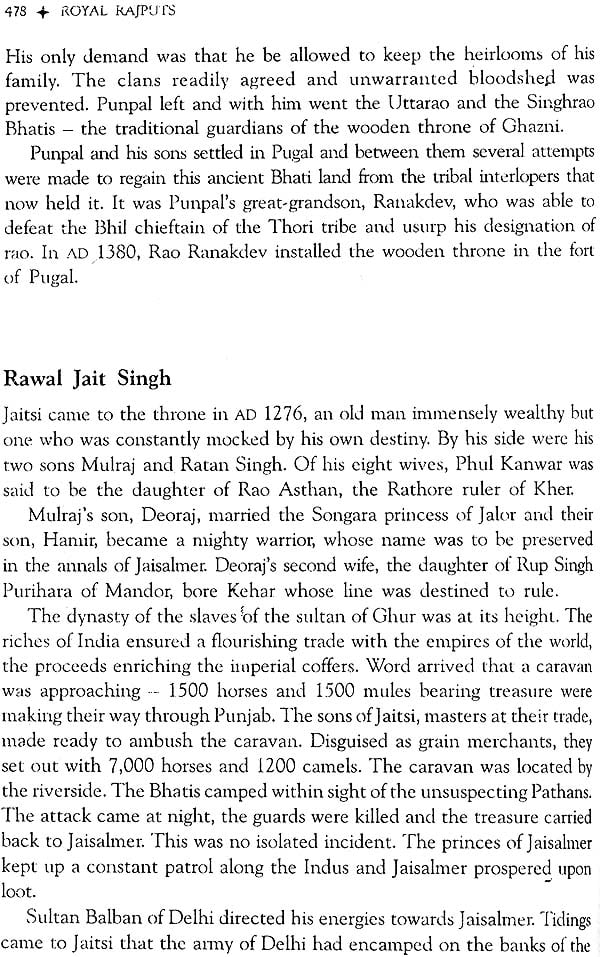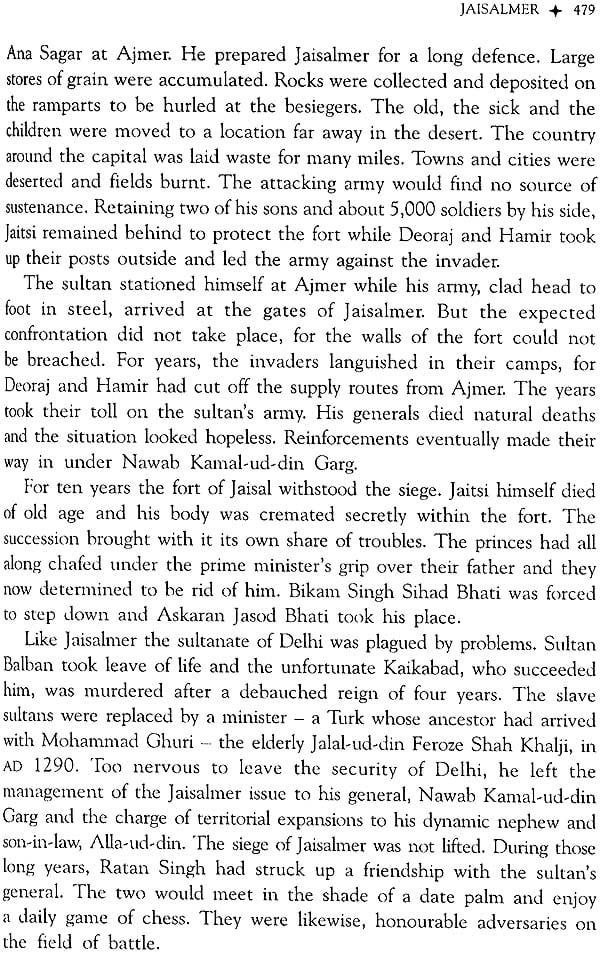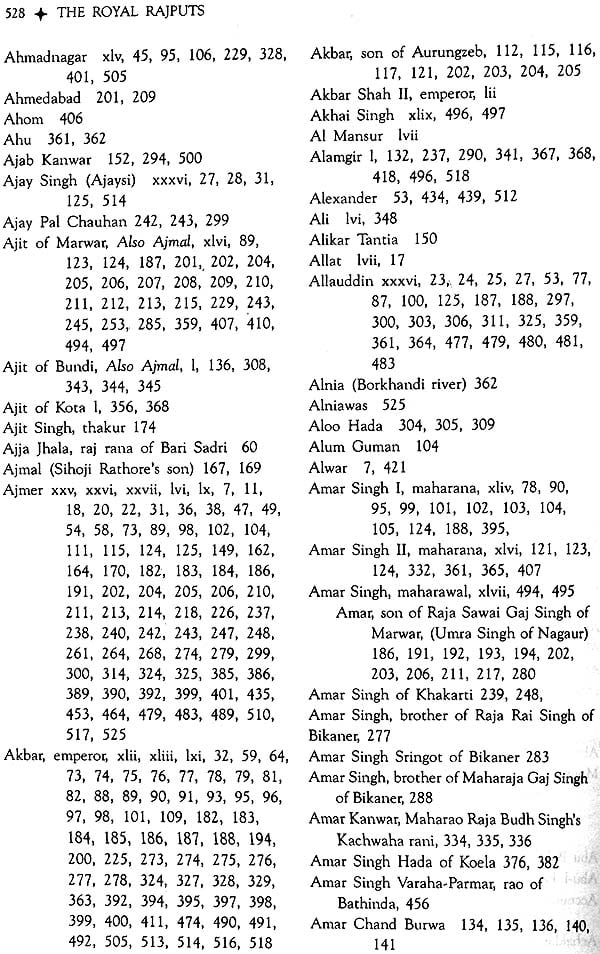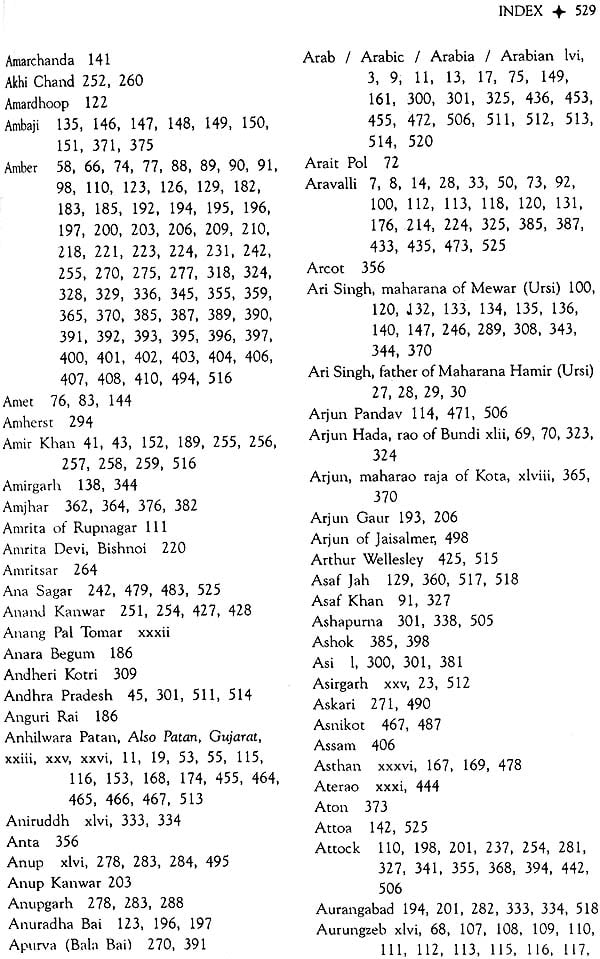
The Royal Rajputs (Strange Tales and Stranger Truths)
Book Specification
| Item Code: | IDK974 |
| Author: | Manoshi Bhattacharya |
| Publisher: | Rupa Publication Pvt. Ltd. |
| Language: | English |
| Edition: | 2014 |
| ISBN: | 9788129114013 |
| Pages: | 616 (27 Color Illustrations & 10 B/W Illustrations) |
| Cover: | Paperback |
| Other Details | 9.1" X 6.1” |
| Weight | 660 gm |
Book Description
The Royal Rajputs – Strange Tales And Stranger Truths renders in simple language and in a concise form the story of Rajasthan. Dr. Manoshi Bhattacharya has worked at untangling a web of myths, legends and folklore skillfully woven by the bards of Rajasthan – one that would test the skills of many a reputed scholar. She has also read many learned narratives on the subject and produced a fine book.
Nepoleon once remarked: what is history but a fable agreed upon, where history fails one turns to legends. Epics are passed down from generation to generation with a certain element of truth, weaving a fabric that holds a people together. The celebrated bards of Rajasthan kept this tradition alive. It was this tribe of wandering minstrels who recited and sang the tales of glory with vigour and passion infusing the haughty Rajputs’ blood with a surge of adrenaline and boundless pride driving them to acts of reckless gallantry. Fuelled with the traditional cup of fiery spirits and a formidable adversary capable of prodigious feats of valour. They yearned only for victory or death. Glory was assured in any case.
This book will help the tourist – both Indian and foreign – to understand the history and legends of Rajasthan, the proud traditions and customs of the Rajputs. Those with a greater interest in history will perhaps be enthused to read and appreciate the real stuff that discerns fact from fable.
The story of the Rajputs is a colorful tapestry growing steadily on the loom of time. For centuries their genealogical memory had been locked away in the custody of the Bhats (hereditary priests) while ballads sung by the charuns (bards) offered but a tantalising view of a veiled world driven by honour and passion. Researching the land and its people yielded a bounty of surprising secrets. From the swashbuckling tales of gallantry and romance emerged the historical account of the men and women who call themselves the descendants of kings.
The Royal Rajputs – Strange Tales and Stranger Truths is also a human tale of scandal and intrigue, moustaches and harems. Custom, tradition and memories born in those early days all have their reasons. So do the locations of battles and forts. Narrated in the light of an unbroken factual history. The Royal Rajputs teems with timeless tales waiting to be told. This book appeals to the lover of history the tourist who wishes that his guide knew more, to traveler spotting a chattri off the beaten track and to all those who revel in a story well told.
Manoshi Bhattacharya. who began her medical career in the Indian Navy, is a practicing general physician in Gurgaon. She is also the author of charting the Deep, the history of the survey and mapping of Indian waters.
Kolkata 26 August 1799: A seventeen-year-old disembarked at the rain-lashed port and looked about with interest. The new land was far from alien. His thoughts strayed for a fleeting moment to the little island home he had left behind. Beyond still reeling from the effects of the Napoleonic wars, as mad King George clung tenuously to his throne and mourned the loss of his American colonies. But turned turmoil was not limited to Europe and America alone. The great Mughal Empire of India, that had been a constant and lucrative trading partner for two centuries, writhed in the throes of a downfall. The blind emperor, Shah Alam, held onto the throne of Delhi, propped up by the Scindias, the foremost among the Maratha warrior clans that had issued like a scourge from their distant home in the hills of Maharashtra. Rapidly gaining control over the northern lands, they had dominated the political scenario wherever they managed a foothold. As Mughal India crumbled, politically important fragments declared independence defying the powers of Delhi. The time was ripe for the realization of British dreams. For many long years the British East India Company had its army poised in the wings, biding time. In the biggest corporate takeover ever, they planned to grab the Grand Mughal’s possessions, a jewel that the British crown would then to lust after. It was on the shores of this land that James Tod stood, he was going to love her as dearly as his own.
The Tods were a widely traveled lot. James Sr. had left his native Scotland to marry Mary Heatly of New York. Hers was an important family, her brothers having held posts as members of the prestigious civil service of the East India Company. James Sr. too sought his fortune in India working as an Indigo planter at Mirzapur (Uttar Pradesh) and then retired to a comfortable life in England. His son, however chose a different path. Not hot him the life of buying and selling indigo. Armed with a letter from his uncle, Patrick Heatly, James Tod Jr reported to the Company’s headquarters.
Young James was attached to the 2nd Bengal European regiment: an infantry regiment, which comprised entirely of European soldiers. He was promoted to lieutenant a year later and after a brief stint with the 14th Native Infantry Regiment, rejoined the 2nd Bengal. It was at this stage that he became involved with the initial efforts of the British in the survey and mapping of India. The Survey of India that had been set up thirty-two years ago had a gigantic project simmering for a while and on 10 April 1802 it was launched from Chennai as ‘The Great Indian Arc of the Meridian’. All surveyors, whether upon land or sea, contributed to the charting of the Indian subcontinent. Names like Lambton, Everest and Radhanath Sikdar, the man who would first calculate the height of Mount Everest, were to go down in history. Together the surveyors divided the land surface into a gigantic web of triangles that spanned mountains, torrents and raging seas. The surface of the earth was to be mapped in one long concerted effort. These peaceful progressive activities were to witness a dramatic shift in 1803. In a swift movement, Lord Lake occupied Delhi and the blind old emperor now ruled in name, a pensioner protected by the army of the East India Company.
That year the 2nd Bengal was transformed into a marine Regiment and setting sail on board the Mornington, Lieutenant Tod left to serve in the Molucca Isles. He returned in 1805, and volunteered to join the 25th Bengal Native Infantry, which had been attached as escort to the British embassy, led by Resident Envoy Graeme Mercer esq., to the court of the Maratha leader, Daulat Rao Scindia, who had recently lost his hold over Delhi, had encamped largely unmapped. Lieutenant Tod undertook the survey and charting largely unmapped. Lieutenant Tod undertook the survey and charting of the routs used by the escort and the first to be completed was the ‘Chittaurgarh to Udaipur’ route map.
In a latter to the government, Lieutenant Colonel RH Colebrooke, the surveyor general, noting that the lieutenant did this more from zeal to promote useful knowledge than from any pecuniary motive, recommended a surveyor’s allowance, of one-and-a-half-thousand rupees, for the period of employment. The remainder was to be calculated once the field book and journals were submitted. But the government seemed to think otherwise. The rupees per month was deemed sufficient.
With a party of twenty men, lieutenant Tod followed Scindia’s camp, spending his time exploring the regions through which the Maratha army marched. In his usual fashion, Scindia spent the greater part of the year harrying and ravaging wherever he went. Agents were recruited to collect data from areas the lieutenant could not personally visit. Please as far as Hyderabad (now in Pakistan), Sind and Multan were covered. The map of the area between the Yamuna and the Narmada was compiled by 1809. Though it opened up a veritable treasure trove, life under the canvas open to the extremes of Indian weather affected his health drastically. He wrote to Surveyor General Colonel John Garstin, that year:
Nothing but the very bad state of my health could have for so long a period prevented me replying to your favour of the 7th June last, so delaying the protraction of Scindia’s camp of my route, to the provinces. So little has my health benefited by a residence in them, that I have been under the necessity of applying for an extension f leave for two months, and as I generally feel better during the cold weather, I hope to resume my labours about its commencement. I have however much doubt whether I shall not be under the necessity of making a voyage to sea, at the commencement of the next hot season, my health having suffered so much, during near 4 years residence I camp, from the nature of my employment and the peculiar situation of being subject to the inclemencies of all weather under the canvas. It is my sincere wish however, that I may be enabled to delay any further temporary absence, till the commencement of 1811, by which period I hope to have my map finished.
The employment of agents, presenting official gifts to people in the petty states and purchasing instruments from England, proved too expensive for his hundred rupees per month allowance, but the recommendation that Lieutenant Tod be put on half a surveyor’s allowance was once again turned down. To ease the burden on the lieutenant, the surveyor general opined that very different qualities were required to make a survey, take, the levels of canals, estimate the cost of undertaking a project and execute the digging, as opposed to the contracting of local help and the supervision of the work. Lieutenant Tod was recommended for the former while Lieutenant J Macartney was played in charge of the latter. Between 1810 and 1811, the land between the Yamuna and the Ganga was surveyed for the construction Lieutenant Tod to the office of postmaster, taking advantage of the peculiar manner in which he was qualified. It enabled the lieutenant to collect a host of geographical information, which aided his work as a surveyor.
By 1812, he was put in command of the escort he had served with during the last seven years, and was promoted to caption on 26 October 1813. That year saw the completion of the charting of the junction of the Chambal and Yamuna, but the effort took its roll upon his health. Submitting the map to Surveyor General Colonel Crawford, he wrote:
This map will since ling have reached you; it has cost any amount of pain and trouble… The consequence was an illness which nearly carried me off and the effect of which I still feel… My geographical pursuits occupy a wide range as far as the Indus to the west and the Narmada to the south. If my health permits, I may next year apply for permission to visit the western deserts; this is a part I have long had in contemplation; but I must consult my health, which is much broken since I have been in this camp. I have had the command of this escort nearly two years and look forward to the expiration of eight years more to join my father in England.
backbreaking research had been requited to fill in the bits that were missing from the map of he central and western Rajput states, and it was on the eve of a general war in 1815, that the first comprehensive map of Rajasthan was presented to the Governor General Marquess of Hastings. It formed the basic of the war campaign.
from 1815 onwards, Captain Tod served as 2nd assistant to the resident at the court of Scindia at Gwalior and on 18 May 1916, was upgraded to 1st assistant, the governor general noting that he was known to the government by his indefatigable activity and conspicuous merit in collecting and arranging historical information concerning the regions of central India, of which so historical information concerning the regions of central India, of which was likely to because at no distant period the theatre of the most interesting operations.
In 1818, Captain Tod was selected to represent the Marques of Hastings at the maharana’s court. The very thought tickled the imagination of his overtly indophile colleague and friend, Ochterlony, the British resident at Delhi.
Tod was too much of a Rajput to deal with the Rajputs.
Ochterlony himself lived and dressed like a Mughal Nobleman.
As resident and political agent to the Western Rajput States, Captain James Tod Became responsible for the agreements that were to be signed between them and the British government of India. In 1819, the integrated princely Rajput states came to be known as Rajputana.
On integration with the Indian Union in 1948, the name Rajputana was changed to Rajsthan.
| Introduction | xv | |
| Timelines | xxix | |
| I. | Mewar | 1 |
| II. | Marwar | 161 |
| III. | Bikaner | 263 |
| IV. | Hadavati – Bundi and Kota | 297 |
| V. | Dhundhar – Amber and Jaipur | 385 |
| VI. | Jaisalmer | 433 |
| Glossary | 505 | |
| Tod Family Tree | 523 | |
| Bibliography | 525 | |
| Index | 527 |
